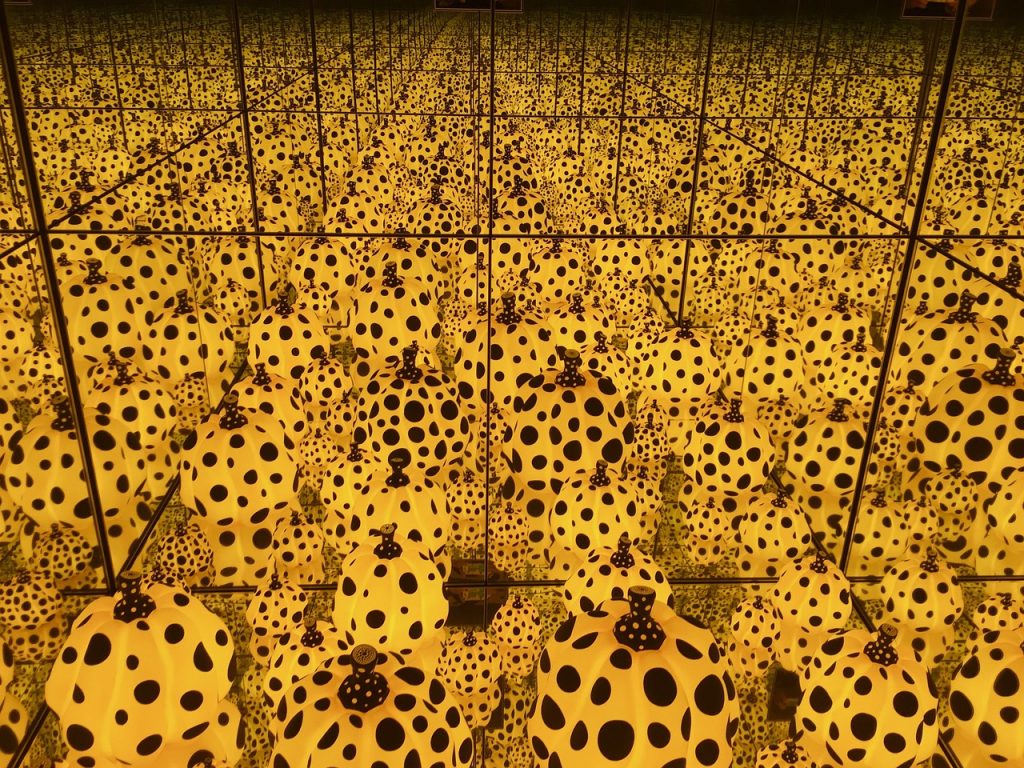by Lorenzo Piero Holder
On my recent visit to the Yayoi Kusama exhibition at the Stedelijk in Schiedam, I was disappointed. While I was eagerly expecting a great photo opportunity I instead encountered an exhibition with a more educational focus, elaborating on the artist’s life and development during her visit to the Netherlands from 1965 until 1970. Unlike other recent shows, the Stedelijk appears to have deliberately avoided the use of artworks as props for self-portraits and instead focuses on educating the public on the artist’s relationship with the Netherlands and contemporary media coverage. While I greatly appreciated the attention to detail, as well as Kusama’s extensive biography I left the museum longing for a new profile picture.
“An iconic selfie.
A conveyer of status and prestige.

Visitors at Yayoi Kusama’s installation, Obliteration Room at Tate.
…Something to flaunt to the world and say, I a, cultured.
Am I expecting too much from the Stedelijk or am exactly the type of person they don’t want?”
As social media expands its prevalence across the cultural sector, evermore galleries and art institutions that once prohibited visitors from taking photographs are now encouraging them. In fact, virality has become a new and important KPI (key success metric) for curators and museum staff, oftentimes informing the exhibition’s overall curatorial strategy.1
However, taking esthetically pleasing shots of artworks and museum displays doesn’t suffice anymore. In a world obsessed with representation and one’s image, nowadays the artwork has to function as a prop for your ego. Afterall, nothing is more prestigious than to have your face captured next to or better yet, inside a world famous artwork.
No artist better exemplifies the exploitation of the selfie phenomenon to drive museum visitors better than Yayoi Kusama. The Japanese artist, whose avant-garde oeuvre frequently features visually repetitive and immersive installations, is one of the world’s most prominent living arts and social media icons. Her globally acclaimed “Infinity Mirrors“, a mesmerizing mirrored room filled with sparkling lights, is probably her most emblematic work in the real of social media.

Yayoi Kusama’s Infinity Mirrors.
By capturing the public’s desire for selfies, Kusama’s installation turns into a craze wherever it is shown. Selfie aficionados and art influencers searching for their latest profile picture would go on a pilgrimage to Kusama’s work and use it as a backdrop for their narcissistic photoshoot.
Something to flaunt to the world and say, I am cultured.
Alas, I wasn’t so lucky this time, but if the rising trend of selfie exhibitions continues to take the world by storm, there will be many more opportunities for art selfies.
Unfortunately for me the Stedelijk in Schiedam pursued a different curatorial route one less in favor of selfies and I will have to continue living with my current profile pic until I have another chance of visiting Yayoi Kusama’s exhibition.
To learn more about selfies in art institutions watch “How ‘Instagram traps’ are changing art museums” on YouTube:
References:
- Suzić, Bojana, Miroslav Karlíček, and Václav Stříteský. “Social media engagement of Berlin and Prague museums.” The Journal of Arts Management, Law, and Society 46, no. 2 (2016): 73-87.


Recent Comments